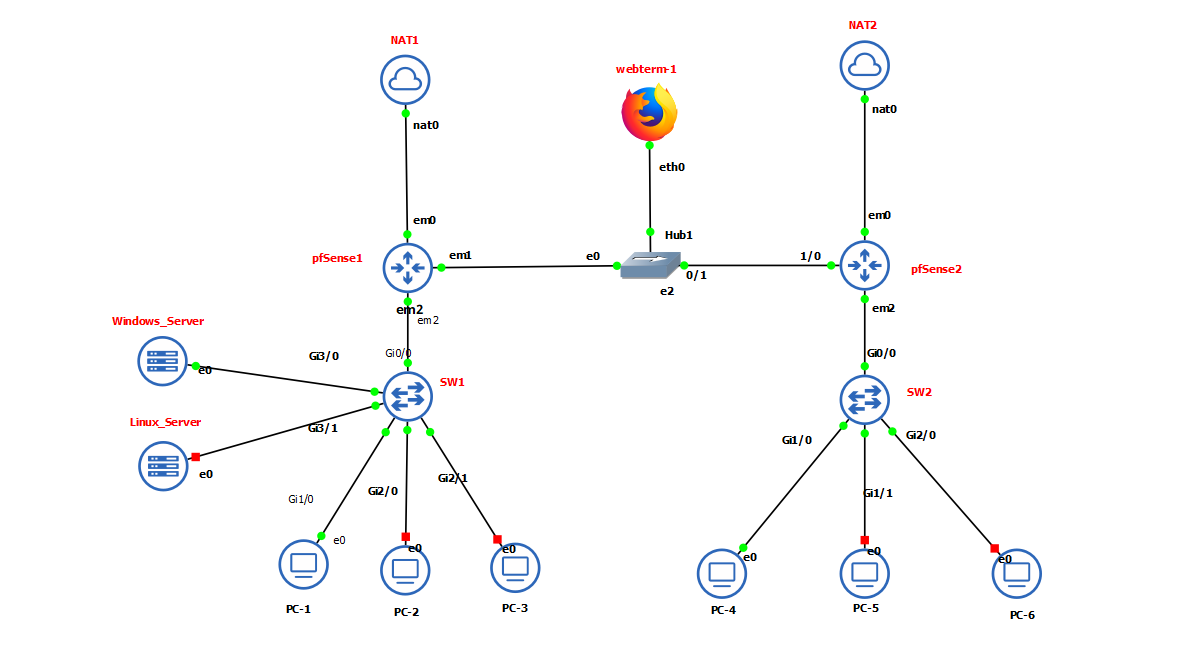SAE 2.04 Integrated Project

In the realm of Networks and Telecommunications, practical experience is invaluable. During my studies, I had the opportunity to participate in the SAE 2.04 Integrated Project, which focused on designing and deploying an IT infrastructure for a company operating across two distinct locations: Saint-Pierre and Saint-Denis. This project not only allowed me to apply my theoretical knowledge but also honed my skills in network simulation, planning, and implementation using the powerful tool GNS3.
Project Overview
The SAE 2.04 Integrated Project aimed to establish a robust and scalable IT infrastructure for a company with operations in two geographically separated sites—Saint-Pierre and Saint-Denis. The primary goal was to ensure seamless connectivity, efficient communication, and secure data exchange between the two locations. To achieve this, we leveraged GNS3 (Graphical Network Simulator-3), a versatile network simulation software that enabled us to design, test, and refine the network setup before actual deployment.
Objectives
- Design a Multi-Site Network Architecture: Develop a network blueprint that connects the two sites efficiently, ensuring high availability and reliability.
- Simulate Network Components: Use GNS3 to model routers, switches, firewalls, and other essential network devices, allowing for thorough testing and optimization.
- Ensure Secure Data Transmission: Implement security measures to protect data integrity and confidentiality across the network.
- Optimize Network Performance: Fine-tune network configurations to achieve optimal performance, minimizing latency and maximizing throughput.
- Facilitate Scalable Growth: Design the infrastructure to accommodate future expansions and technological advancements without significant overhauls.
Tools and Technologies Used
- GNS3: Utilized for network simulation and testing, enabling us to create a virtual environment that mirrors real-world network conditions.
- Cisco IOS: Employed within GNS3 to configure and manage network devices, ensuring compatibility and reliability.
- VLANs (Virtual Local Area Networks): Implemented to segment network traffic, enhancing security and reducing congestion.
- VPN (Virtual Private Network): Established secure tunnels between the two sites to protect data transmission over the internet.
- Routing Protocols: Configured protocols such as OSPF (Open Shortest Path First) to facilitate efficient data routing between network segments.
Key Tasks and Responsibilities
1. Network Design and Planning
The initial phase involved comprehensive planning and design of the network architecture. We began by assessing the company's requirements, including the number of users, types of applications, data storage needs, and security considerations. Based on this assessment, we drafted a detailed network diagram outlining the placement of routers, switches, firewalls, and other critical components for both sites.
2. Simulation with GNS3
Using GNS3, we created a virtual representation of the proposed network. This simulation allowed us to:
- Configure Network Devices: Set up routers and switches with appropriate settings, including IP addressing, routing protocols, and VLAN configurations.
- Test Connectivity: Verify the connectivity between devices within each site and across the two locations, ensuring that data flows seamlessly.
- Identify and Resolve Issues: Detect potential bottlenecks, security vulnerabilities, and configuration errors in the virtual environment before actual deployment.
3. Security Implementation
Ensuring the security of the network was paramount. We implemented several security measures, including:
- Firewalls: Configured firewalls to monitor and control incoming and outgoing network traffic based on predetermined security rules.
- VPN Tunnels: Established VPN tunnels between Saint-Pierre and Saint-Denis to encrypt data transmission, safeguarding against unauthorized access and data breaches.
- Access Control Lists (ACLs): Defined ACLs to restrict access to sensitive network segments, ensuring that only authorized personnel could access critical resources.
4. Performance Optimization
To optimize network performance, we fine-tuned various configurations:
- VLAN Segmentation: Segmented the network into VLANs to reduce broadcast domains, minimize congestion, and improve overall efficiency.
- Quality of Service (QoS): Implemented QoS policies to prioritize essential traffic, ensuring that critical applications received the necessary bandwidth and minimal latency.
- Load Balancing: Configured load balancing mechanisms to distribute network traffic evenly across multiple paths, enhancing reliability and preventing single points of failure.
5. Documentation and Training
Comprehensive documentation was created to detail the network setup, configurations, and operational procedures. Additionally, training sessions were conducted for the company's IT staff to ensure they were equipped to manage and troubleshoot the new infrastructure effectively.
Skills Developed
- Network Simulation and Design: Enhanced my ability to design complex network architectures and simulate them using advanced tools like GNS3.
- Configuration Management: Gained hands-on experience in configuring routers, switches, firewalls, and implementing routing protocols.
- Security Best Practices: Developed a strong understanding of network security principles, including the implementation of firewalls, VPNs, and ACLs.
- Problem-Solving: Improved my troubleshooting skills by identifying and resolving issues within the simulated network environment.
- Project Management: Learned to manage a project from inception to completion, including planning, execution, documentation, and training.
Conclusion
The SAE 2.04 Integrated Project was an enriching experience that provided me with practical insights into designing and implementing a secure multi-site IT infrastructure. Utilizing GNS3 allowed for thorough testing and optimization, ensuring that the final network setup was both reliable and efficient. This project not only solidified my technical skills in network design and security but also underscored the importance of meticulous planning and proactive problem-solving in successful IT deployments.
This hands-on project serves as a testament to my capability to deliver comprehensive IT solutions that meet the dynamic needs of modern businesses. It stands as a valuable addition to my professional portfolio, showcasing my expertise in creating secure, scalable, and high-performing network infrastructures.
